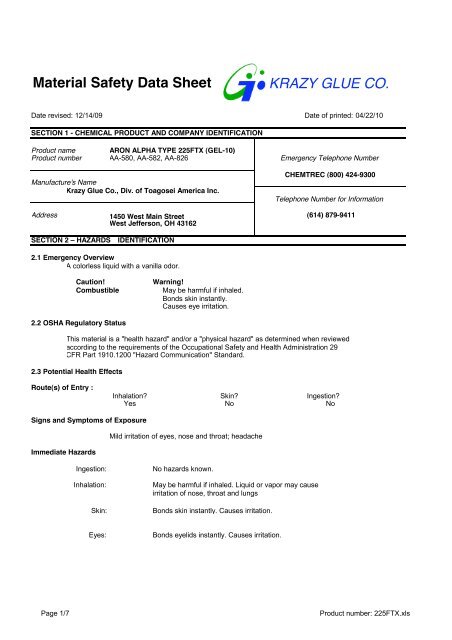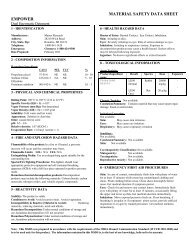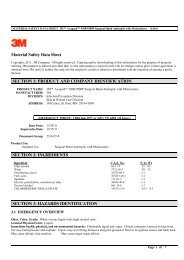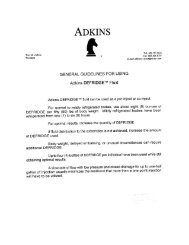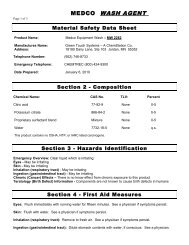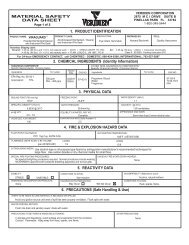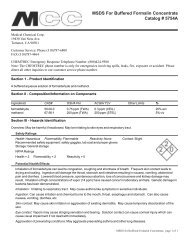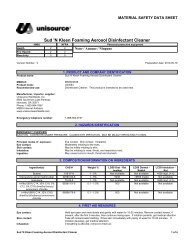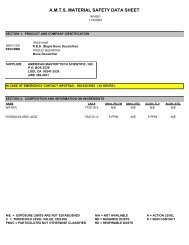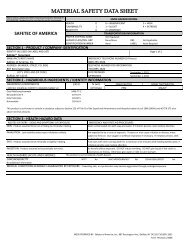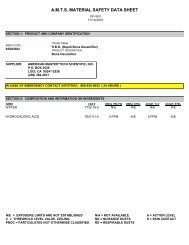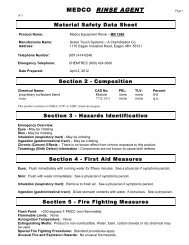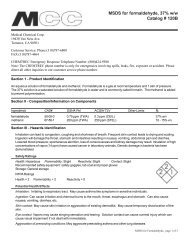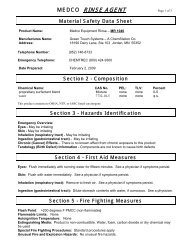Adhesive Gel - Southland Medical Corporation
Adhesive Gel - Southland Medical Corporation
Adhesive Gel - Southland Medical Corporation
Create successful ePaper yourself
Turn your PDF publications into a flip-book with our unique Google optimized e-Paper software.
Material Safety Data SheetKRAZY GLUE CO.Date revised: 12/14/09Date of printed: 04/22/10SECTION 1 - CHEMICAL PRODUCT AND COMPANY IDENTIFICATIONProduct nameProduct numberARON ALPHA TYPE 225FTX (GEL-10)AA-580, AA-582, AA-826Emergency Telephone NumberManufacture's NameKrazy Glue Co., Div. of Toagosei America Inc.CHEMTREC (800) 424-9300Telephone Number for InformationAddress 1450 West Main Street (614) 879-9411West Jefferson, OH 43162SECTION 2 – HAZARDSIDENTIFICATION2.1 Emergency OverviewA colorless liquid with a vanilla odor.Caution!CombustibleWarning!May be harmful if inhaled.Bonds skin instantly.Causes eye irritation.2.2 OSHA Regulatory StatusThis material is a "health hazard" and/or a "physical hazard" as determined when reviewedaccording to the requirements of the Occupational Safety and Health Administration 29CFR Part 1910.1200 "Hazard Communication" Standard.2.3 Potential Health EffectsRoute(s) of Entry :Inhalation? Skin? Ingestion?Yes No NoSigns and Symptoms of ExposureImmediate HazardsMild irritation of eyes, nose and throat; headacheIngestion:Inhalation:Skin:No hazards known.May be harmful if inhaled. Liquid or vapor may causeirritation of nose, throat and lungsBonds skin instantly. Causes irritation.Eyes:Bonds eyelids instantly. Causes irritation.Page 1/7Product number: 225FTX.xls
Health Hazards(Acute and Chronic)Skin: Rapid polymerization will occur on skin with heat. If a quantity is large, skin burnmay happen.Inhalation: High vapor concentration can induce nasal mucous, headaches, and giddinessEye: Irritation and lachyrymation will occur slightly<strong>Medical</strong> Conditions Generally Aggravated by ExposureNoneNote:None of the components present in this product at concentrations equalto or greater than 0.1% have been listed by NTP, classified by IARC,nor regulated by OSHA as a carcinogen.SECTION 3 - COMPOSITION / INFORMATION ON INGREDIENTSComponents (Specific Chemical Identity;Common Name(s) and CAS number)%(Optional)1 Ethyl 2-Cyanoacrylate 84-93(CAS NO. 7085-85-0)2 Polymethylmetacrylate 2-6(CAS NO. 9011-14-7)3 Fumed Silica 5-10(CAS NO. 68611-44-9)4 Polypropylene glycol
EYES:If eye contact occurs, hold eyelid open and rinse thoroughly but gently with only waterfor 15 minutes and GET MEDICAL ATTENTION. Do not use any solvents to flush theeye and its surroundings. Liquid glue will sting eye temporarily. Solidified glue mayirritate eye like a grain of sand and should be treated by an eye doctor.SECTION 5 -FIRE FIGHTING MEASURES5.1 Flammable PropertiesSee section 9 for flammable properties.5.2 Extinguishing Media5.2.1 Suitable extinguishing mediaUse dry chemical or carbon dioxide (CO 2 ) to extinguish fire.5.2.2 Unsuitable extinguishing mediaDo not use water spray to extinguish fire.5.3 Protection of firefighters5.3.1 Specific hazards arising form the chemicalUnusual Fire and Explosion HazardsNone known5.3.2 Protective equipment and precautions for firefightersSelf-contained breathing apparatus with face piece and protective clothingif involved in a fire of other materialsSECTION 6 - ACCIDENTAL RELEASE MEASURES6.1 Personal precautionsUse personal protection recommended in Section 8. Isolate the hazard area anddeny entry to unnecessary and unprotected personnel. Avoid breathing vapors. Ventilate area.6.2 Environmental precautionsPrevent entry into natural bodies of water.6.3 Methods for containmentMaterial may be taken up on sand or clay absorbent.For small quantities : Soak up with absorbent material and remove to a chemical disposal area.For large quantities : Wipe and soak up material with an absorbent material.6.4 Methods for clean-upEliminate all sources of ignition.Immerse absorbent in a pail of water or suitable, close container and dispose of as hazardous waste.Page 3/7Product number: 225FTX.xls
SECTION 7 -HANDLING AND STORAGE7.1 Handling7.2 StorageHandle in accordance with good industrial hygiene and safety practices. These practices include avoidingunnecessary exposure and removal of the material from eyes, skin and clothing. Wash thoroughlyafter handling.Keep away from amines. Store in a cool, dry area away from sun and heat.Keep containers tightly closed. Exposure to small amounts of moisture, even in air, causes polymerizationand renders the product unusable. Keep away from heat, sparks, flame and other ignition sources.SECTION 8 -PERSONAL PROTECTION / EXPOSURE CONTROLS8.1 Exposure guidelinesComponentEthyl 2-CyanoacrylatePolymethylmetacrylateFumed SilicaPolypropylene glycolHydroquinoneN. E. = Not establishedOSHA ACGIHTWA TWA UnitsN. E. 1 mg/m 3N. E. N. E. -See Note 2 mg/m 3N.E. N. E. -2 2 mg/m 3Note: OSHA PEL : 20 mppcf; 80/(%SiO2)mg/m3 TWA Remanded PEL : 6mg/m3TWA (as Silica)OSHA 1989 PEL remanded, but in effect in some states8.2 Engineering controlsThe following exposure control techniques may be used to effectively minimize employee exposure:local exhaust ventilation, enclosed system design, process isolation and remote control incombination with appropriate use of personal protective equipment and prudent work practices.These techniques may not necessarily address all issues pertaining to your operations. We,therefore, recommend that you consult with experts of your choice to determine whether or not yourprograms are adequate.8.3 Personal protection equipment (PPE)8.3.1 Eye/face protection8.3.2 Skin protectionWear safety goggles when contact is likely.Wear impervious gloves as required to prevent skin contact.8.3.3 Respiratory protectionWhere air contaminants can exceed acceptable criteria, use NIOSH/MSHA approved respiratoryprotection equipment. Respirators should be selected based on the form and concentration ofcontaminants in air in accordance OSHA laws and regulations or other applicable standards orguidelines, including ANSI standards regarding respiratory protection.8.3.4 General hygiene considerationsHandle in accordance with good industrial hygiene and safety practice. Wash hands before breaks and at the endof workday. Avoid breathing vapor. Avoid contact with skin and eyes.Page 4/7Product number: 225FTX.xls
SECTION 9 - PHYSICAL AND CHEMICAL PROPERTIESAppearanceOdorOdor ThresholdPhysical StatepHFreezing PointBoiling Point (@ 532 Pa)Flash Point (Closed Cup)Evaporation Rate (Butyl acetate = 1)Lower explosion limitUpper explosion limitClear, colorless liquidVanillaN/ALiquidN/A-20°C62°C/144 o F83°C/181°FN/AN/AN/AVapor Pressure (mmHg @ 20!)0.13(Pa @ 20!) 17.33Vapor Density (AIR = 1)Specific Gravity (H2O = 1 @ 25!)Solubility in WaterVOC content (g/L)Partition coefficientAuto-ignition temperatureDecomposition temperatureViscosity>11.05Insoluble, water causes rapid polymerization0 (SCAQMD Method 316B)N/AN/AN/A170,000 cpsSECTION 10 - STABILITY AND REACTIVITY10.1 Chemical stability10.2 Conditions to avoidUnstable:Stable:XHigh humidity, high temperature or ultraviolet ray.10.3 Incompatible materials(Materials to Avoid)10.4 Hazardous decomposition productsWater, alcohol and basic compounds such as amines.CO, CO 2 , nitrogen oxidesPage 5/7Product number: 225FTX.xls
10.5 Possibility of hazardous reactionsMay Occur:Not Occur:XAvoid contact with basic compounds such as amines.SECTION 11 - TOXICOLOGICAL INFORMATIONAcute toxicityNo data availableIrritation and corrosionNo data availableSensitizationNo data availableSECTION 12 - ECOLOGICAL INFORMATIONNo data available.SECTION 13 - DISPOSAL INFORMATIONDisposal should be in accordance with applicable local, regional and national laws and regulations.Local regulations may be more stringent than regional or national requirements.May contain explosive vapors. DO NOT cut, puncture or weld on or nearby.SECTION 14 – TRANSPORT INFORMATION14.1 Basic shipping descriptionThe data provided in this section is for information only and may not be specific to your package size.You will need to apply the appropriate regulations to properly classify your shipment for transportation.US DOTNot dangerous goodsIATANot dangerous goods14.2 Additional InformationCanadian TDGWHMIS Classification: this product has been classified in accordance with the hazard criteria of theCPR, and the MSDS contains all the information required by the CPR.SECTION 15 - REGULATORY INFORMATION15.1 U.S. Federal RegulationsSARA Title III: Section 311/312Fire hazardImmediate health hazardPage 6/7Product number: 225FTX.xls
SARA Title III Section 313 and 40 CFR Part 372This product contains the following toxic chemical(s) subject to the reporting requirementsof Section 313 of Title III of the Superfund Amendments and Reauthorization Act of 1986,and Subpart C-Supplier Notification Requirement of 40 CFR Part 372.None required per SARA TITLE III SECTION 313.TSCA Section 8(b) Inventory15.2 Canadian RegulationsAll reportable chemical substances are listed on the TSCA Inventory.We rely on certifications of compliance from our suppliers for chemical substances notmanufactured by us.Workplace Hazardous Materials Information System (WHMIS)This product has been classified in accordance with the hazard criteria of theControlled Products Regulation (CPR) and the MSDS contains all the information requiredby the CPR.CLASS D, DIV 1B, 2BCLASS B, DIV 3Canadian Environmental Protection Act (CEPA)All reportable chemical substances are listed on the Domestic Substances List (DSL)or otherwise comply with CEPA new substance notification requirements.National Pollutant Release Inventory (NPRI)SECTION 16- OTHER INFORMATIONThis product contains the following chemical(s) subject to the reporting requirementsof the Canadian Environmental Protection Act (CEPA) subsection 16(1), NationalPollutant Release Inventory.NoneTo the best of our knowledge, the information contained herein is accurate. However, neither ToagoseiAmerica Ltd. nor any of its subsidiaries any liability whatsoever for the accuracy or completeness of theinformation contained herein. Final determination of suitability of any material is the sole responsibilityof the user. All materials may present unknown hazards and should be used with caution.Although certain hazards are described herein, we cannot guarantee that these are the only hazardswhich exist.HMIS Rating Health 2Flammability 2Physical Hazard 10-minimal, 1-slight, 2-moderate, 3-serious, 4-severePage 7/7Product number: 225FTX.xls


